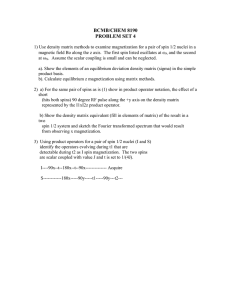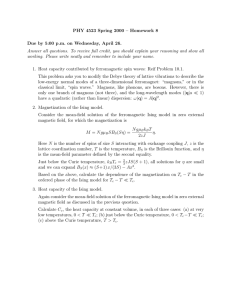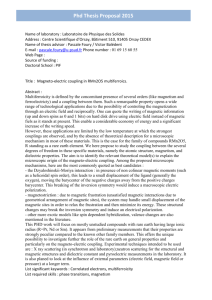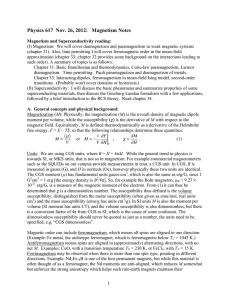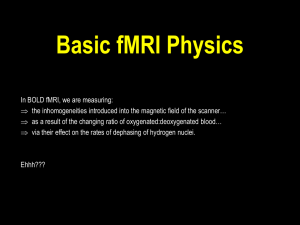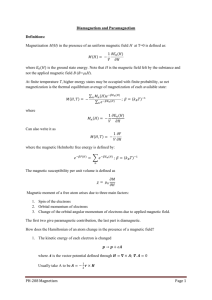TD9 Statistical Physics (M1)
advertisement
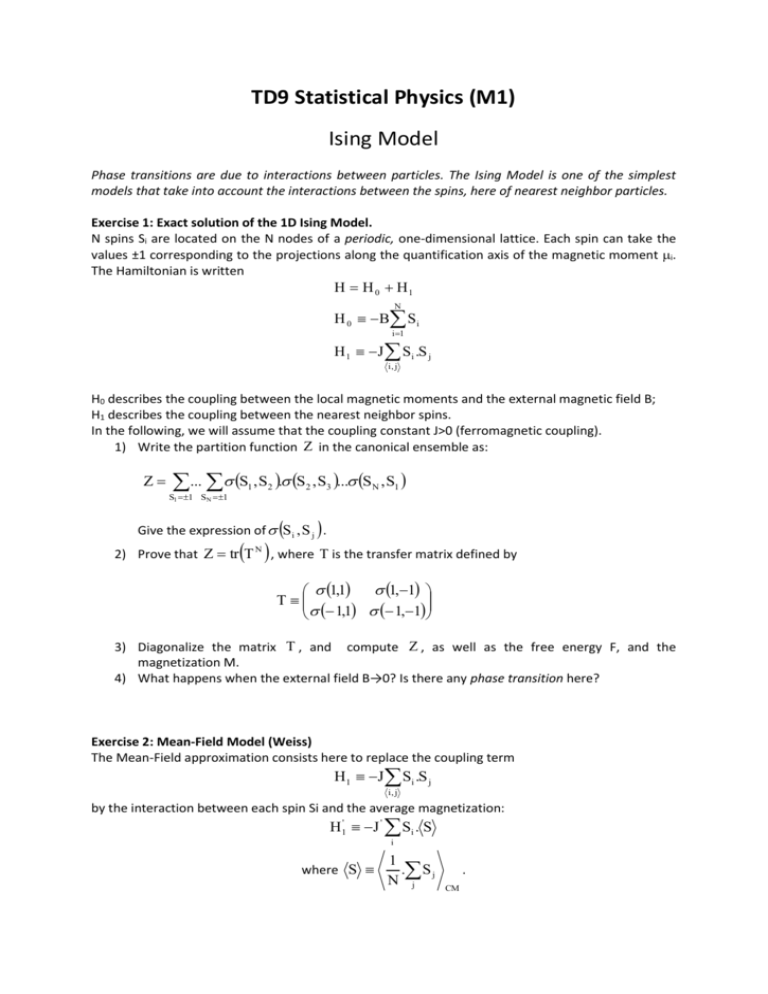
TD9 Statistical Physics (M1)
Ising Model
Phase transitions are due to interactions between particles. The Ising Model is one of the simplest
models that take into account the interactions between the spins, here of nearest neighbor particles.
Exercise 1: Exact solution of the 1D Ising Model.
N spins Si are located on the N nodes of a periodic, one-dimensional lattice. Each spin can take the
values ±1 corresponding to the projections along the quantification axis of the magnetic moment i.
The Hamiltonian is written
H H 0 H1
N
H 0 B S i
i 1
H 1 J S i .S j
i, j
H0 describes the coupling between the local magnetic moments and the external magnetic field B;
H1 describes the coupling between the nearest neighbor spins.
In the following, we will assume that the coupling constant J>0 (ferromagnetic coupling).
1) Write the partition function Z in the canonical ensemble as:
Z
... S , S . S , S ... S
S1 1 SN 1
1
2
2
3
N
, S1
Give the expression of S i , S j .
, where T is the transfer matrix defined by
2) Prove that Z tr T
N
1,1
1,1
T
1,1 1,1
3) Diagonalize the matrix T , and compute Z , as well as the free energy F, and the
magnetization M.
4) What happens when the external field B→0? Is there any phase transition here?
Exercise 2: Mean-Field Model (Weiss)
The Mean-Field approximation consists here to replace the coupling term
H1 J Si .S j
i, j
by the interaction between each spin Si and the average magnetization:
H1' J ' Si . S
i
where S
1
. S j
N j
.
CM
In the last equation, the statistical average is performed with the approximate hamiltonian
H CM H 0 H 1' .
1) Compute the partition function ZCM and the free energy FCM within this approximation.
2) Write the self-consistent equation allowing to compute the average magnetization of the
system. What are the conditions allowing to the existence of a residual magnetization when
the external magnetic field B is cancelled (goes to zero)?
3) Calculate the fluctuations M 2
CM
M
2
CM
of the magnetization within this approximation.
Exercise 3: Spins correlations.
This exercice is devoted to the study of fluctuations and correlations inside the system, and its
relation to the magnetic susceptibility, in the canonical ensemble.
We consider the Ising model of N spins with long-range mutual interactions, in a non-uniform
external magnetic field B. The Hamiltonian is written:
H H 0 H1
N
H 0 B i .Si
i 1
H 1 J ij .Si .S j
i j
Bi is the magnetic field acting on the ith spin.
1) Write the expression of the partition function ZN({Bi}) of the N spins in the canonical
ensemble, for a given set of {Bi} (1≤i≤N).
2) Write <Si>, <Si.Sj>, and the total magnetization M of the system as a function of partial
derivatives of the free energy F.
What is the relation between Gij=<SiSj>-<Si>.<Sj> and the response function M / Bi ?
Gij measures the correlation between the orientation of a spin Si and the orientation of
another spin Sj. When these orientations are completely decorrelated, Gij=0.
3) When the external magnetic field B is uniform (Bi=B) write the relation between Gij and the
magnetic susceptibility . This is called the Fluctuation-Dissipation theorem.
4) When B→0, and when the Hamiltonian is replaced by its mean field expression consisting
into replacing Si.Sj by Si.<Sj>+<Si>.Sj - <Si>.<Sj>, check that Gij=0.
